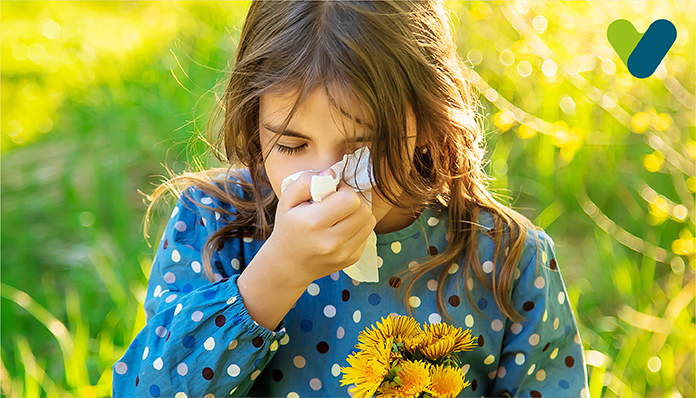Allergies in Children
Allergies are immune system issues. The human's immune system reacts to a "false alarm" in the majority of allergy reactions. The human body defends itself typically against dangerous organisms such as viruses and bacteria. However, the defences occasionally launch powerful attacks on harmless substances like dust, mould, or pollen.Allergens are usually harmless. However, when a person suffers from allergies, the body interprets these allergens as hazardous. The body then uses antibodies called immunoglobulin E to combat allergens (IgE). Antibodies are connected to individual mast cells. Antibodies bind to allergens which causes histamine and other substances to be released by mast cells, resulting in an allergic reaction. Nasal allergy symptoms occur when substances irritate surrounding nasal tissue. This can induce asthma symptoms such as cough and wheeze in the lungs' breathing tubes. A severe allergic reaction occurs when the response affects the entire body.
Symptoms of Allergies in A Child
Anywhere in the body can trigger an allergic reaction. Lining, nose, sinuses, skin, eyes, stomach, throat, and lungs are among the organs affected. Immune system cells are found in these locations to combat germs inhaled, swallowed, or come into touch with the skin. Allergies can result in:- Sneezing, itching, or runny nose, as well as irritation in the ears or the mouth.
- Red, itchy, watery eyes.
- Red, itchy, dry skin.
- Hives or itchy welts.
- Itchy rash.
- Asthma symptoms include coughing, wheezing, Shortness of breath.
- An allergic reaction that is severe and potentially fatal, Breathing difficulties, vomiting, diarrhoea, low blood pressure, fainting, or death may result.
Reasons for Allergies in A Child
A variety of factors can trigger allergies. However, the following are the most prevalent allergens or triggers:- Pollen from trees, grasses, and weeds
- Latex made of natural rubber
- Dust mites
- Dander from animals, urine, and skin oil
- Foods.
- Medicines.
- Feathers.
- Stings from bees.
- Cockroaches and mice
Treatment for Allergies in Children
It's critical to get an accurate allergy diagnosis. Your doctor will be able to rule out any other possible causes for your symptoms and assist you in determining the root of the problem. Once you understand what is causing the allergic reaction, you will avoid it and avoid future difficulties. To avoid wasting time avoiding wrongly identified triggers, seek medical guidance before removing anything from your child's diet or making any radical adjustments at home. The most famous study is skin prick tests, which are painless and well accepted by children. A blood test may be required on occasion, which will be performed by a children's phlebotomist who is experienced in the procedure and will use 'cold spray' or anaesthetic cream to minimise your child's discomfort. If your kid has an allergy, your doctor may prescribe medicine to help manage the symptoms if they react.Common Health Issues in Children
Allergies: Allergies develop when your child's immune system reacts to items in the environment that are usually considered innocuous by most people, such as foods, insect stings, dust mites, animals, or pollen. If your child has an allergy, consult your doctor.Asthma: If your child has asthma, they may have a whistling wheeze when breathing, be short of breath while exercising or relaxing, have a persistent dry cough, or cough after physical activity or at night. If your child has any symptoms of asthma, consult your doctor.
Colds: Colds can strike children as frequently as once a month. Fluids, comfort, and rest are usually the best treatments. Antibiotics aren't going to help. Consult your doctor if you suspect it's something more severe than a cold.
Food intolerances: Food intolerances are allergic reactions to a particular food. Diarrhoea and stomach pain are common symptoms that go away on their own. If you suspect your child has a food intolerance, consult your doctor.
Gastroenteritis: Gastroenteritis ('gastro') affects a large number of children. Diarrhoea, loss of appetite, vomiting, nausea, stomach pains, and fever are symptoms. Although most episodes of gastroenteritis in children aren't dangerous, it's crucial to make sure your child drinks plenty of water.
Hand, foot and mouth disease: Small blisters appear within the mouth and on the hands and feet due to the hand, foot, and mouth disease. These aren't scratchy at all. It's a minor infection that won't hurt you.
Impetigo: Impetigo, often known as school sores, appears as flat, red spots or small blisters on your child's body. The sites may fill with yellow or green pus, explode, or crust over. The blisters itch a lot. If you suspect your child has impetigo, take them to the doctor since antibiotics are required. Because impetigo is very contagious, keep your child at home for at least 24 hours after starting antibiotic treatment.
Lice or nits: These insects cl to children's hair, lay eggs (often called nits), and causes scratching and irritation. Lice may be removed from wet hair by combing with conditioner or using anti-lice treatments. Keep your child at home until the lice have been treated.
Warts: A wart is a raised growth that is tiny and flesh-coloured. They're most commonly found on children's arms, hands, and legs. The majority of warts are painless. Consult your doctor if the wart is on your child's face, foot, or genitals or if it is red, hot, or painful.
Worms: An itchy or red bottom is one of the worms' symptoms. Worms are usually harmless. Antiparasitic medications, which you may get over the counter at your local drugstore, are a simple way to cure them. The whole family should be treated at the same time. Infections frequently recur, especially in children who attend child care, preschool, or school.


